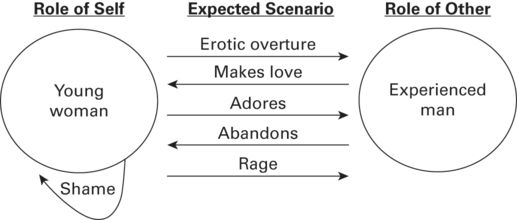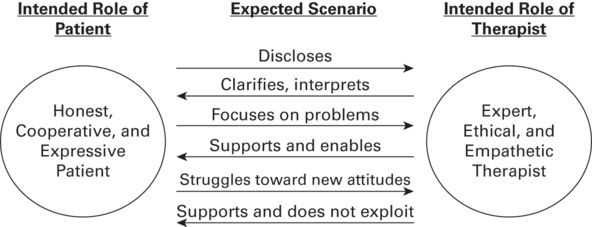Early phase of Amber’s maladaptive pattern
Amber sat down looking distressed. The therapist said, “Please let it be enough that I understand the longing for love that you are feeling. Can you tolerate your distress and longing for a while? I want to talk it over with you, without hugging.” The therapist maintained a calm demeanor. Amber then cried and expressed feelings of being rejected. The therapist said, “It is a good sign that you can put this into words.” Amber had been in an under-modulated state. She then shifted into a more controlled working state, in which she understood what was going on and could process ideas – hers and the therapist’s – in an ongoing emotional conversation. This episode was examined in serial sessions.
In those sessions, the therapist and Amber used verbal labels to clarify the respective roles of self and other as they were enacted in stories about her important previous sexual relationships. Through these discussions her hopes were clarified and interpreted in relation to the new current narratives of her past experiences. The desired role-relationship model depicted in Figure 7.1 was clarified, including her usual maladaptive transformation into the dreaded pattern of rejection and desperate loneliness. The end story of the pattern of relationship ruptures is depicted in Figure 7.2.

Later phase of Amber’s maladaptive pattern
As Amber re-enacted her core attitude in a series of transference states and therapeutic alliance states, the therapist’s responses led to progress in further clarifying the roles in their deepening therapeutic alliance. Her trust gradually increased with the therapist’s continued non-critical responses that promoted insight and conversation. She expressed sadness as she reconsidered her narrative about her childhood abuse from a stance of reflective self-awareness.
The consistency and enriched realization of the therapeutic alliance was an important corrective relationship experience. In the new relationship experience, the therapist showed his value of caring for her as a person and his interest in her personality growth. The frame was clear: there would never be engagement of a sexual relationship. The therapeutic alliance as experienced by Amber is shown in Figure 7.3

Roles of a relationship in a therapeutic alliance
For a therapist to enable a patient to learn from new experiences, he or she needs to be aware of and avoid two technical errors. As discussed earlier in by Table 6.2 as a dilemma: the therapist should not be so warm as to indicate a possible boundary crossing, and the therapist should not be so cold as to appear remote, which can be misinterpreted by the patient as being totally rejecting. In Amber’s case, the therapist maintained eye contact to avoid appearing remote and did not offer to reciprocate a hug.
As with Amber, a therapist may respond to seductive behaviors by setting appropriate boundaries defining the limits of the relationship, while emphasizing mutual trust-building and verbal communication. The patient may react angrily at first if they feel rejected. However, the patient will eventually recognize that what is occurring in therapy is not rejection. Instead, it is a compassionate and restrained form of continuous caring, as shown in Figure 7.4. Figure 7.4 shows the new role-relationship model of the therapeutic alliance as eventually experienced by Amber. The process was helped along by verbal clarifications and appraisals. Some of the therapist’s intended actions and statements to Amber are illustrated in Table 7.1.

Learning from the evolving therapeutic alliance




